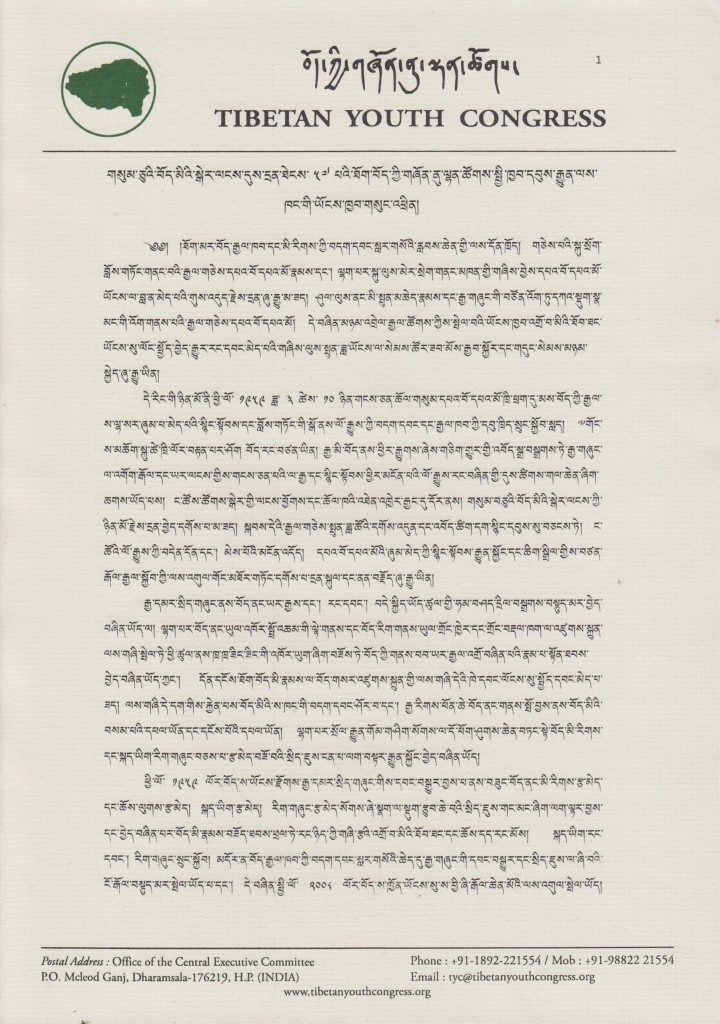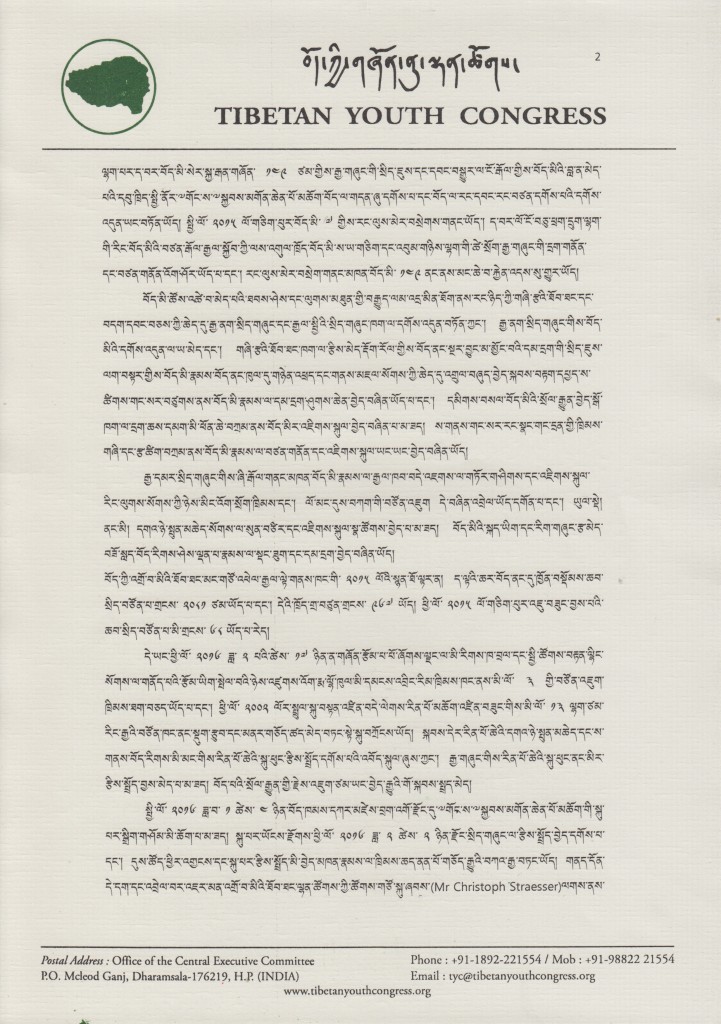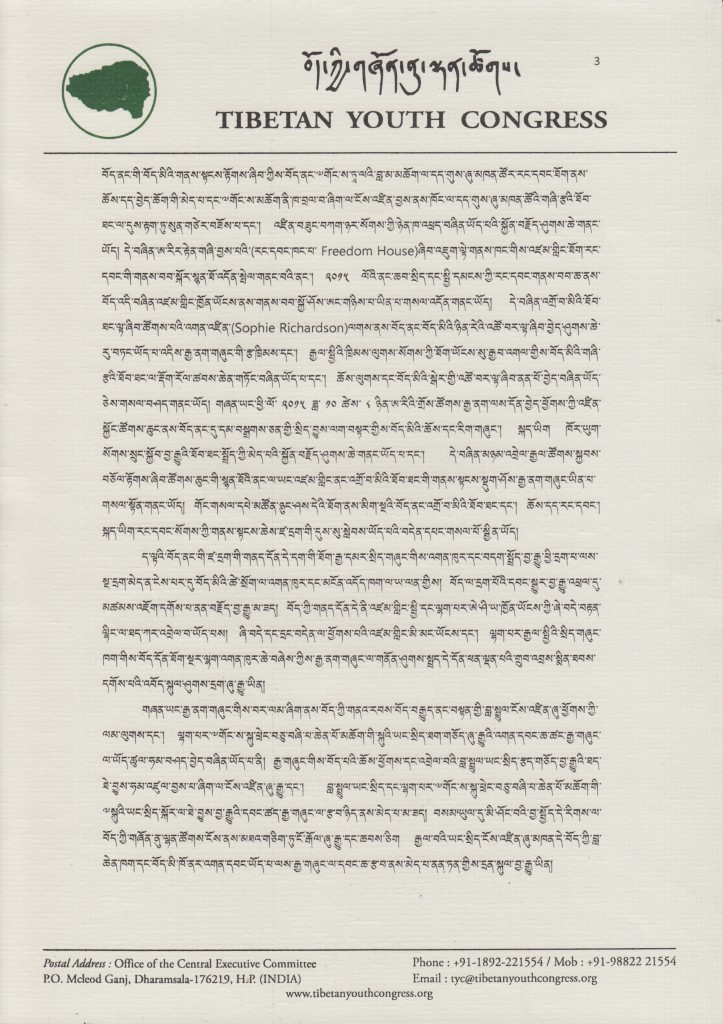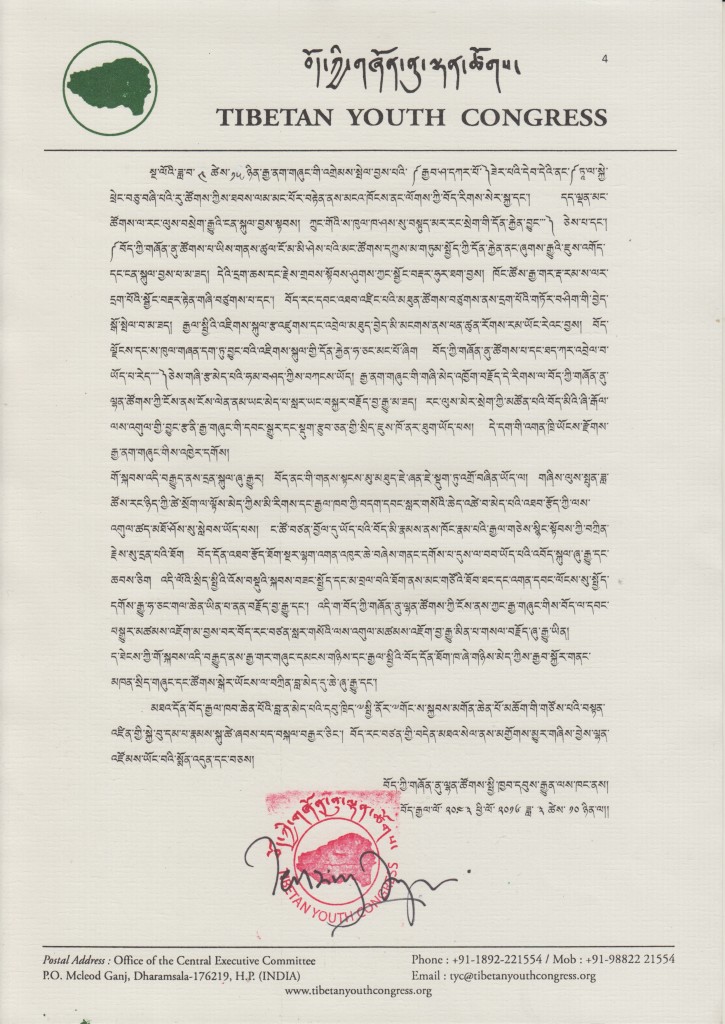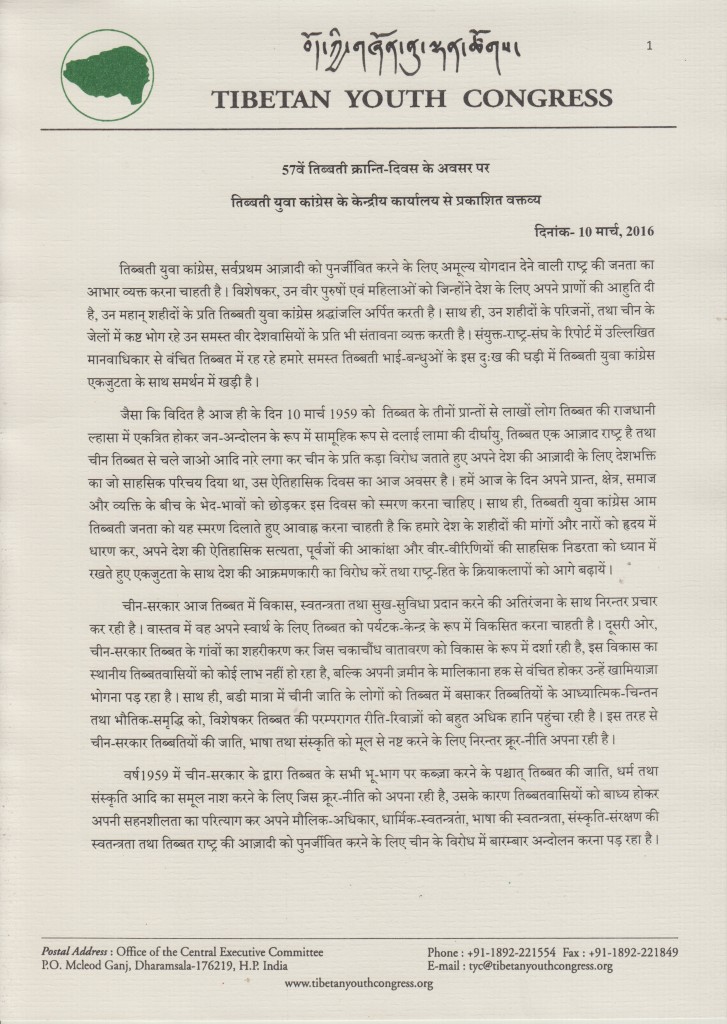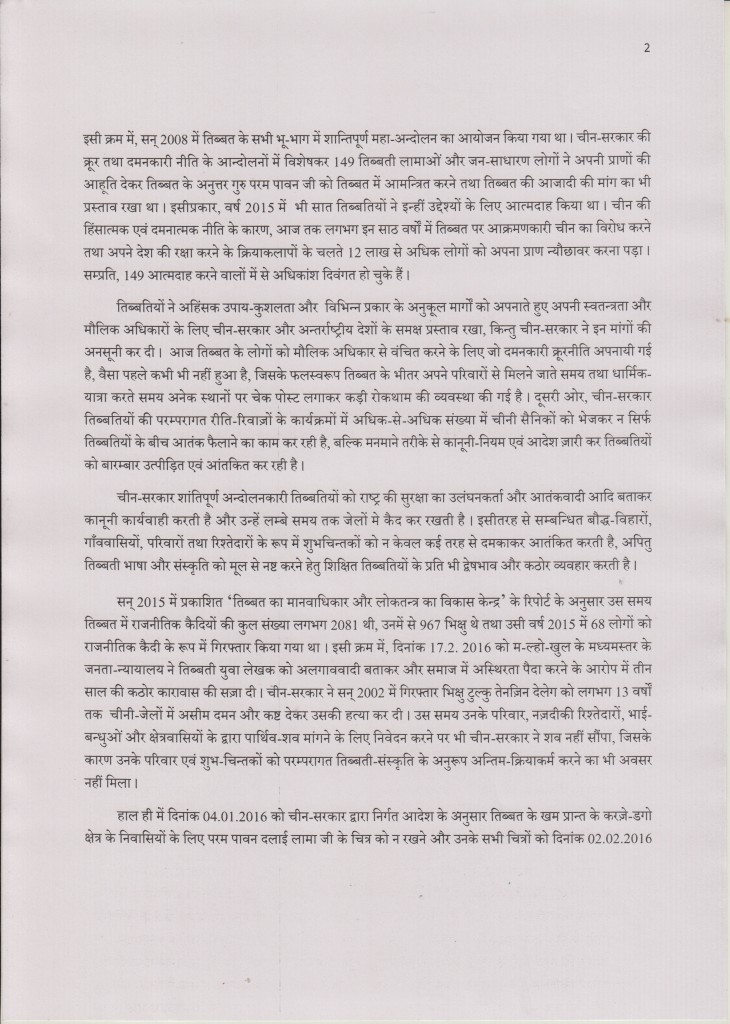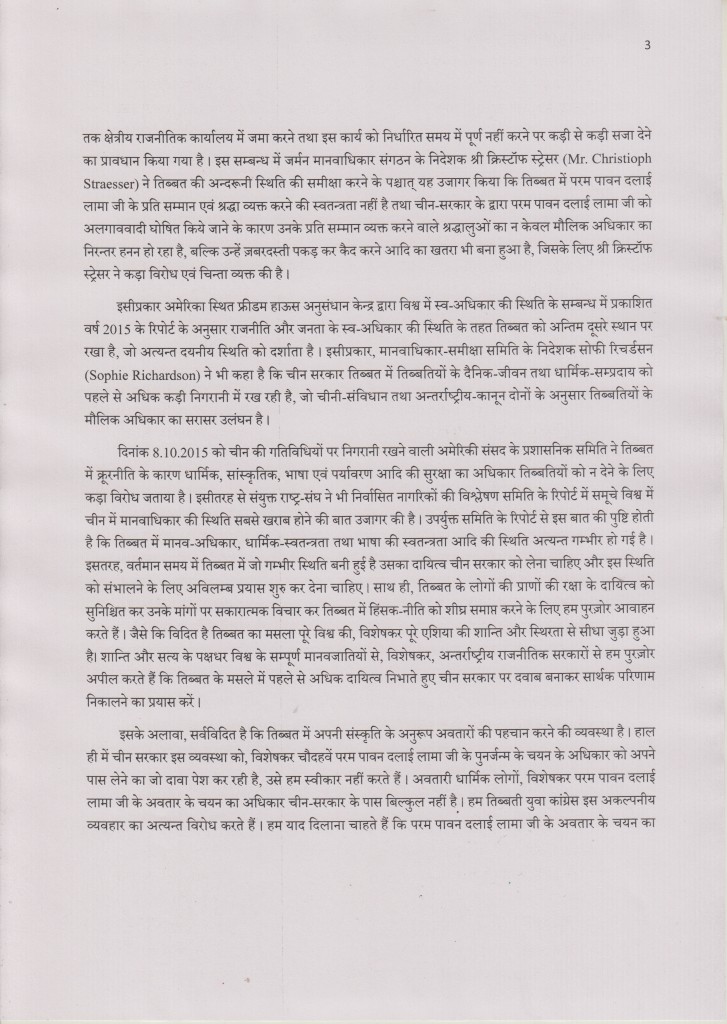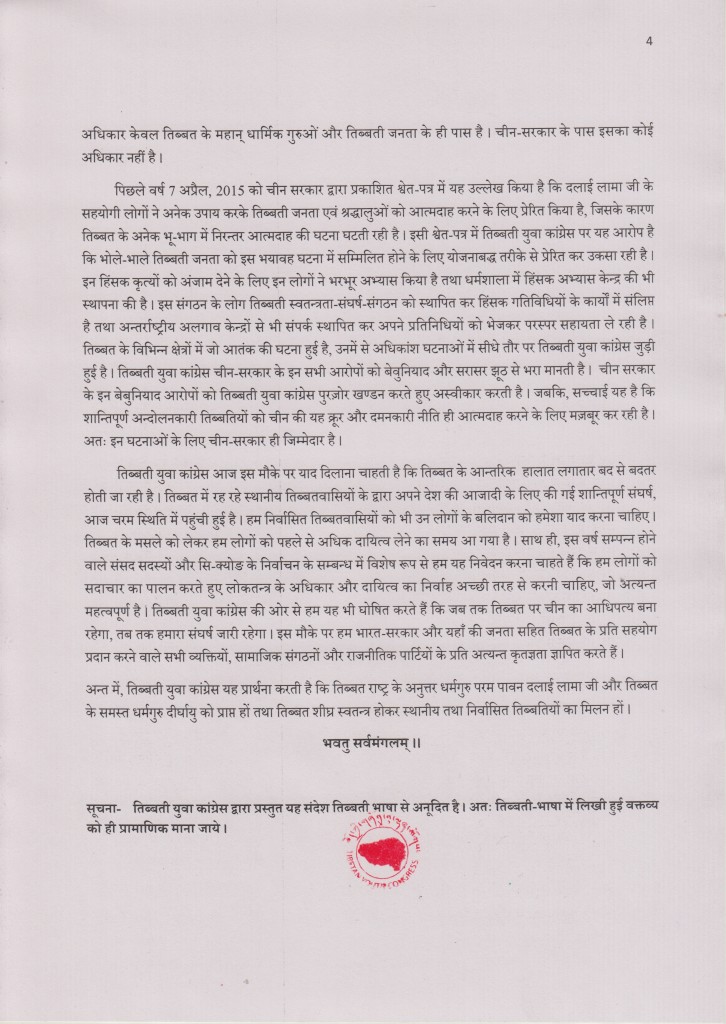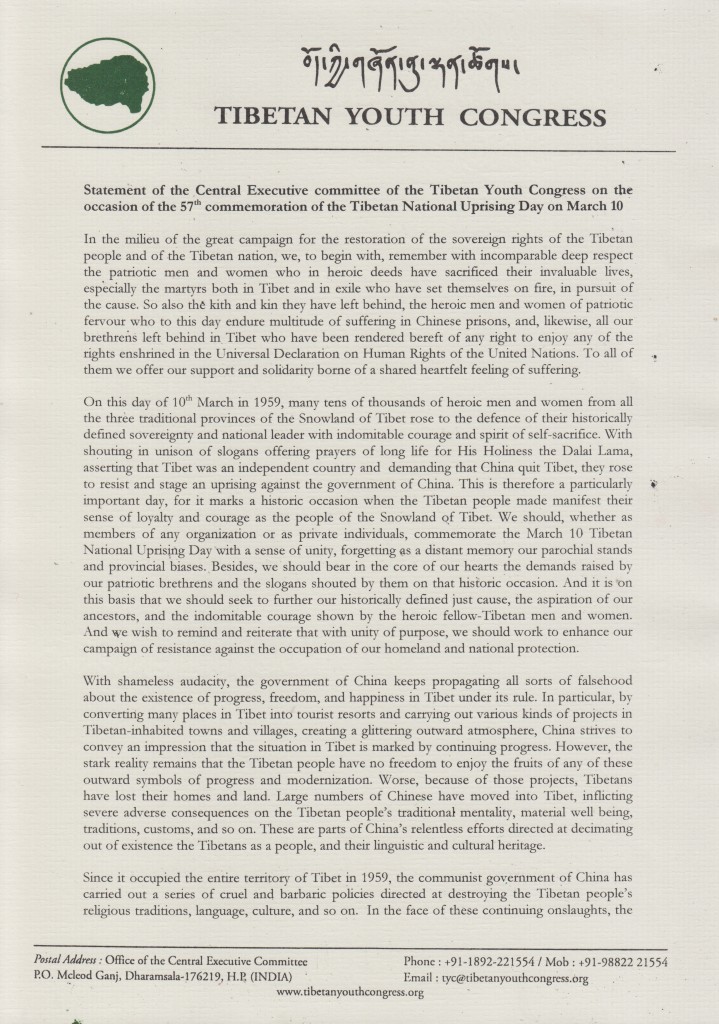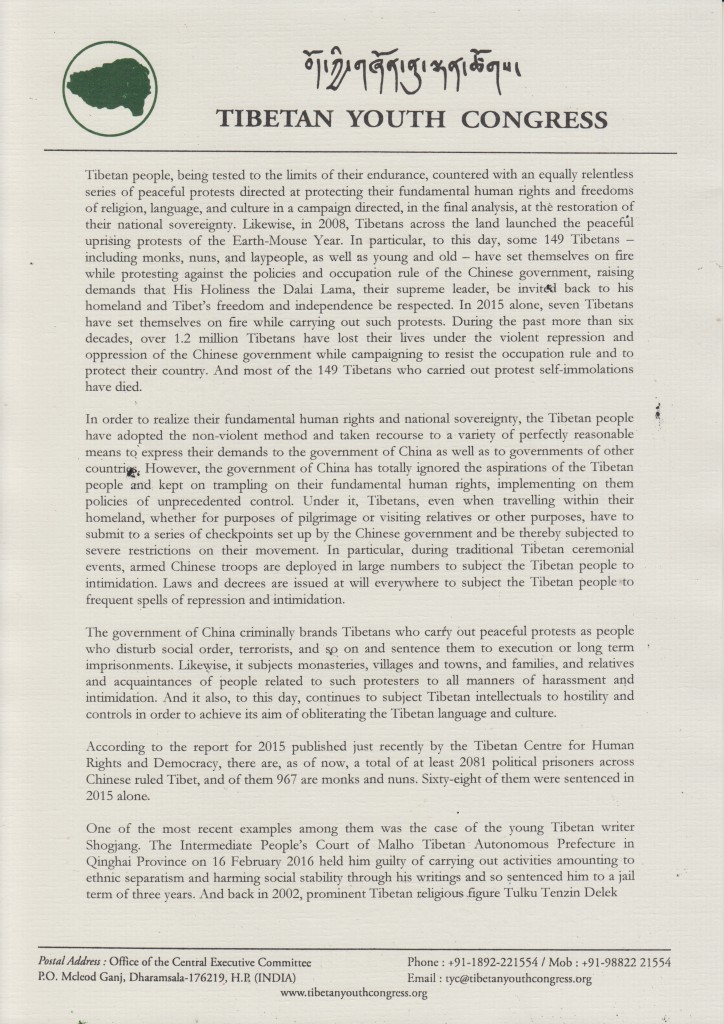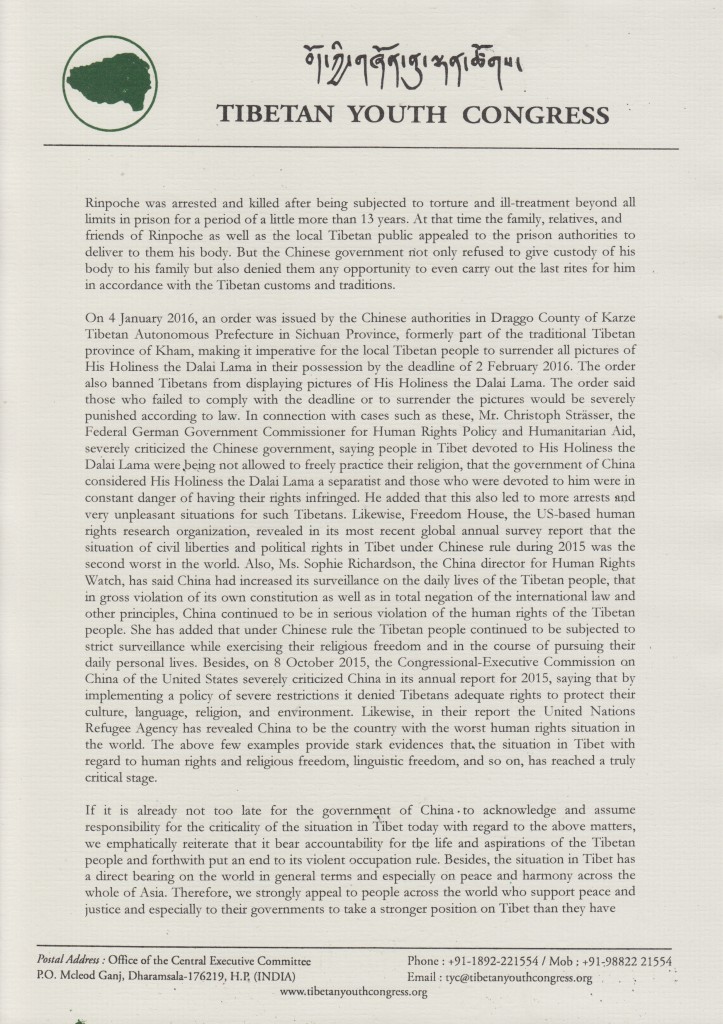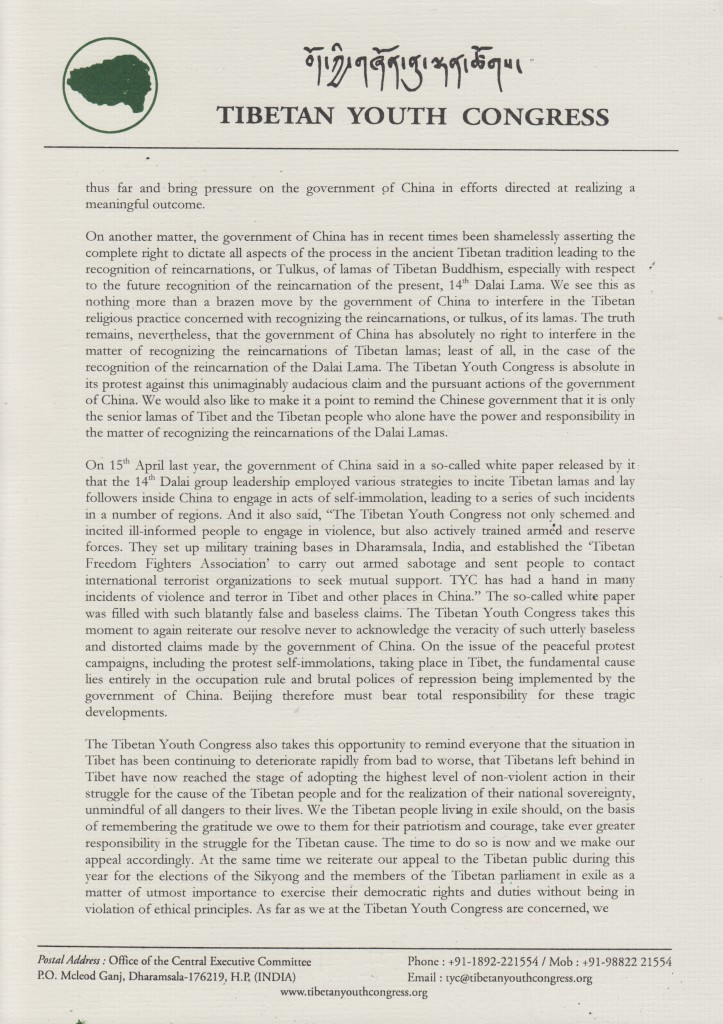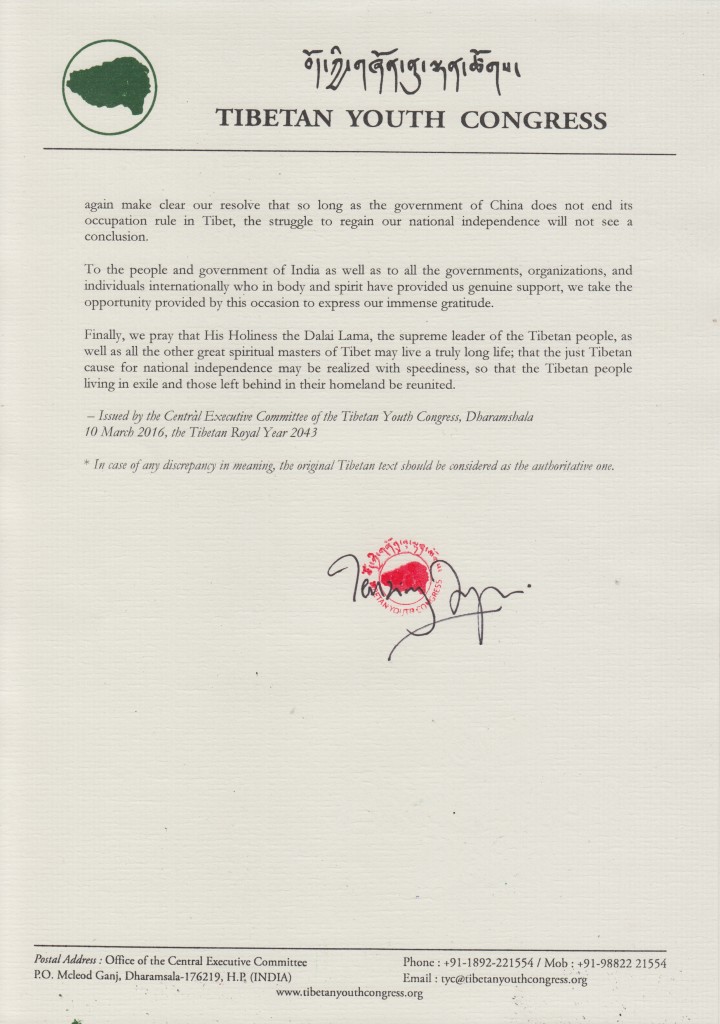In the milieu of the great campaign for the restoration of the sovereign rights of the Tibetan people and of the Tibetan nation, we, to begin with, remember with incomparable deep respect the patriotic men and women who in heroic deeds have sacrificed their invaluable lives, especially the martyrs both in Tibet and in exile who have set themselves on fire, in pursuit of the cause. So also the kith and kin they have left behind, the heroic men and women of patriotic fervour who to this day endure multitude of suffering in Chinese prisons, and, likewise, all our brethrens left behind in Tibet who have been rendered bereft of any right to enjoy any of the rights enshrined in the Universal Declaration on Human Rights of the United Nations. To all of them we offer our support and solidarity borne of a shared heartfelt feeling of suffering.
On this day of 10th March in 1959, many tens of thousands of heroic men and women from all the three traditional provinces of the Snowland of Tibet rose to the defence of their historically defined sovereignty and national leader with indomitable courage and spirit of self-sacrifice. With shouting in unison of slogans offering prayers of long life for His Holiness the Dalai Lama, asserting that Tibet was an independent country and is hH demanding that China quit Tibet, they rose to resist and stage an uprising against the government of China. This is therefore a particularly important day, for it marks a historic occasion when the Tibetan people made manifest their sense of loyalty and courage as the people of the Snowland of Tibet. We should, whether as members of any organization or as private individuals, commemorate the March 10 Tibetan National Uprising Day with a sense of unity, forgetting as a distant memory our parochial stands and provincial biases. Besides, we should bear in the core of our hearts the demands raised by our patriotic brethrens and the slogans shouted by them on that historic occasion. And it is on this basis that we should seek to further our historically defined just cause, the aspiration of our ancestors, and the indomitable courage shown by the heroic fellow-Tibetan men and women. And we wish to remind and reiterate that with unity of purpose, we should work to enhance our campaign of resistance against the occupation of our homeland and national protection.
With shameless audacity, the government of China keeps propagating all sorts of falsehood about the existence of progress, freedom, and happiness in Tibet under its rule. In particular, by converting many places in Tibet into tourist resorts and carrying out various kinds of projects in Tibetan-inhabited towns and villages, creating a glittering outward atmosphere, China strives to convey an impression that the situation in Tibet is marked by continuing progress. However, the stark reality remains that the Tibetan people have no freedom to enjoy the fruits of any of these outward symbols of progress and modernization. Worse, because of those projects, Tibetans have lost their homes and land. Large numbers of Chinese have moved into Tibet, inflicting severe adverse consequences on the Tibetan people’s traditional mentality, material well being, traditions, customs, and so on. These are parts of China’s relentless efforts directed at decimating out of existence the Tibetans as a people, and their linguistic and cultural heritage.
Since it occupied the entire territory of Tibet in 1959, the communist government of China has carried out a series of cruel and barbaric policies directed at destroying the Tibetan people’s religious traditions, language, culture, and so on. In the face of these continuing onslaughts, the Tibetan people, being tested to the limits of their endurance, countered with an equally relentless series of peaceful protests directed at protecting their fundamental human rights and freedoms of religion, language, and culture in a campaign directed, in the final analysis, at the restoration of their national sovereignty. Likewise, in 2008, Tibetans across the land launched the peaceful uprising protests of the Earth-Mouse Year. In particular, to this day, some 149 Tibetans – including monks, nuns, and laypeople, as well as young and old – have set themselves on fire while protesting against the policies and occupation rule of the Chinese government, raising demands that His Holiness the Dalai Lama, their supreme leader, be invited back to his homeland and Tibet’s freedom and independence be respected. In 2015 alone, seven Tibetans have set themselves on fire while carrying out such protests. During the past more than six decades, over 1.2 million Tibetans have lost their lives under the violent repression and oppression of the Chinese government while campaigning to resist the occupation rule and to protect their country. And most of the 149 Tibetans who carried out protest self-immolations have died.
In order to realize their fundamental human rights and national sovereignty, the Tibetan people have adopted the non-violent method and taken recourse to a variety of perfectly reasonable means to express their demands to the government of China as well as to governments of other countries. However, the government of China has totally ignored the aspirations of the Tibetan people and kept on trampling on their fundamental human rights, implementing on them policies of unprecedented control. Under it, Tibetans, even when travelling within their homeland, whether for purposes of pilgrimage or visiting relatives or other purposes, have to submit to a series of checkpoints set up by the Chinese government and be thereby subjected to severe restrictions on their movement. In particular, during traditional Tibetan ceremonial events, armed Chinese troops are deployed in large numbers to subject the Tibetan people to intimidation. Laws and decrees are issued at will everywhere to subject the Tibetan people to frequent spells of repression and intimidation.
The government of China criminally brands Tibetans who carry out peaceful protests as people who disturb social order, terrorists, and so on and sentence them to execution or long term imprisonments. Likewise, it subjects monasteries, villages and towns, and families, and relatives and acquaintances of people related to such protesters to all manners of harassment and intimidation. And it also, to this day, continues to subject Tibetan intellectuals to hostility and controls in order to achieve its aim of obliterating the Tibetan language and culture.
According to the report for 2015 published just recently by the Tibetan Centre for Human Rights and Democracy, there are, as of now, a total of at least 2081 political prisoners across Chinese ruled Tibet, and of them 967 are monks and nuns. Sixty-eight of them were sentenced in 2015 alone.
One of the most recent examples among them was the case of the young Tibetan writer Shogjang. The Intermediate People’s Court of Malho Tibetan Autonomous Prefecture in Qinghai Province on 16 February 2016 held him guilty of carrying out activities amounting to ethnic separatism and harming social stability through his writings and so sentenced him to a jail term of three years. And back in 2002, prominent Tibetan religious figure Tulku Tenzin Deleg Rinpoche was arrested and killed after being subjected to torture and ill-treatment beyond all limits in prison for a period of a little more than 13 years. At that time the family, relatives, and friends of Rinpoche as well as the local Tibetan public appealed to the prison authorities to deliver to them his body. But the Chinese government not only refused to give custody of his body to his family but also denied them any opportunity to even carry out the last rites for him in accordance with the Tibetan customs and traditions.
On 4 January 2016, an order was issued by the Chinese authorities in Draggo County of Karze Tibetan Autonomous Prefecture in Sichuan Province, formerly part of the traditional Tibetan province of Kham, making it imperative for the local Tibetan people to surrender all pictures of His Holiness the Dalai Lama in their possession by the deadline of 2 February 2016. The order also banned Tibetans from displaying pictures of His Holiness the Dalai Lama. The order said those who failed to comply with the deadline or to surrender the pictures would be severely punished according to law. In connection with cases such as these, Mr. Christoph Strässer, the Federal German Government Commissioner for Human Rights Policy and Humanitarian Aid, severely criticized the Chinese government, saying people in Tibet devoted to His Holiness the Dalai Lama were being not allowed to freely practice their religion, that the government of China considered His Holiness the Dalai Lama a separatist and those who were devoted to him were in constant danger of having their rights infringed. He added that this also led to more arrests and very unpleasant situations for such Tibetans. Likewise, Freedom House, the US-based human rights research organization, revealed in its most recent global annual survey report that the situation of civil liberties and political rights in Tibet under Chinese rule during 2015 was the second worst in the world. Also, Ms. Sophie Richardson, the China director for Human Rights Watch, has said China had increased its surveillance on the daily lives of the Tibetan people, that in gross violation of its own constitution as well as in total negation of the international law and other principles, China continued to be in serious violation of the human rights of the Tibetan people. She has added that under Chinese rule the Tibetan people continued to be subjected to strict surveillance while exercising their religious freedom and in the course of pursuing their daily personal lives. Besides, on 8 October 2015, the Congressional-Executive Commission on China of the United States severely criticized China in its annual report for 2015, saying that by implementing a policy of severe restrictions it denied Tibetans adequate rights to protect their culture, language, religion, and environment. Likewise, in their report the United Nations Refugee Agency has revealed China to be the country with the worst human rights situation in the world. The above few examples provide stark evidences that the situation in Tibet with regard to human rights and religious freedom, linguistic freedom, and so on, has reached a truly critical stage.
If it is already not too late for the government of China to acknowledge and assume responsibility for the criticality of the situation in Tibet today with regard to the above matters, we emphatically reiterate that it bear accountability for the life and aspirations of the Tibetan people and forthwith put an end to its violent occupation rule. Besides, the situation in Tibet has a direct bearing on the world in general terms and especially on peace and harmony across the whole of Asia. Therefore, we strongly appeal to people across the world who support peace and justice and especially to their governments to take a stronger position on Tibet than they have thus far and bring pressure on the government of China in efforts directed at realizing a meaningful outcome.
On another matter, the government of China has in recent times been shamelessly asserting the complete right to dictate all aspects of the process in the ancient Tibetan tradition leading to the recognition of reincarnations, or Tulkus, of lamas of Tibetan Buddhism, especially with respect to the future recognition of the reincarnation of the present, 14th Dalai Lama. We see this as nothing more than a brazen move by the government of China to interfere in the Tibetan religious practice concerned with recognizing the reincarnations, or tulkus, of its lamas. The truth remains, nevertheless, that the government of China has absolutely no right to interfere in the matter of recognizing the reincarnations of Tibetan lamas; least of all, in the case of the recognition of the reincarnation of the Dalai Lama. The Tibetan Youth Congress is absolute in its protest against this unimaginably brazen claim and the pursuant actions of the government of China. We would also like to make it a point to remind the Chinese government that it is only the senior lamas of Tibet and the Tibetan people who alone have the power and responsibility in the matter of recognizing the reincarnations of the Dalai Lamas.
On 15th April last year, the government of China said in a so-called white paper released by it that the 14th Dalai group leadership employed various strategies to incite Tibetan lamas and lay followers inside China to engage in acts of self-immolation, leading to a series of such incidents in a number of regions. And it also said, “The Tibetan Youth Congress not only schemed and incited ill-informed people to engage in violence, but also actively trained armed and reserve forces. They set up military training bases in Dharamsala, India, and established the ‘Tibetan Freedom Fighters Association’ to carry out armed sabotage and sent people to contact international terrorist organizations to seek mutual support. TYC has had a hand in many incidents of violence and terror in Tibet and other places in China.” The so-called white paper was filled with such brazenly false and baseless claims. The Tibetan Youth Congress takes this moment to again reiterate our resolve never to acknowledge the veracity of such utterly baseless and distorted claims made by the government of China. On the issue of the peaceful protest campaigns, including the protest self-immolations, taking place in Tibet, the fundamental cause lies entirely in the occupation rule and brutal polices of repression being implemented by the government of China. Beijing therefore must bear total responsibility for these tragic developments.
The Tibetan Youth Congress also takes this opportunity to remind everyone that the situation in Tibet has been continuing to deteriorate rapidly from bad to worse, that Tibetans left behind in Tibet have now reached the stage of adopting the highest level of non-violent action in their struggle for the cause of the Tibetan people and for the realization of their national sovereignty, unmindful of all dangers to their lives. We the Tibetan people living in exile should, on the basis of remembering the gratitude we owe to them for their patriotism and courage, take ever greater responsibility in the struggle for the Tibetan cause. The time to do so is now and we make our appeal accordingly. At the same time we reiterate our appeal to the Tibetan public during this year for the elections of the Sikyong and the members of the Tibetan parliament in exile as a matter of utmost importance to exercise their democratic rights and duties without being in violation of ethical principles. As far as we at the Tibetan Youth Congress are concerned, we again make clear our resolve that so long as the government of China does not end its occupation rule in Tibet, the struggle to regain our national independence will not see a conclusion.
To the people and government of India as well as to all the governments, organizations, and individuals internationally who in body and spirit have provided us genuine support, we take the opportunity provided by this occasion to express our immense gratitude.
Finally, we pray that His Holiness the Dalai Lama, the supreme leader of the Tibetan people, as well as all the other great spiritual masters of Tibet may live a truly long life; that the just Tibetan cause for national independence may be realized with speediness, so that the Tibetan people living in exile and those left behind in their homeland be reunited.
– Issued by the Central Executive Committee of the Tibetan Youth Congress, Dharramshala
10 March 2016, the Tibetan Royal Year 2043
